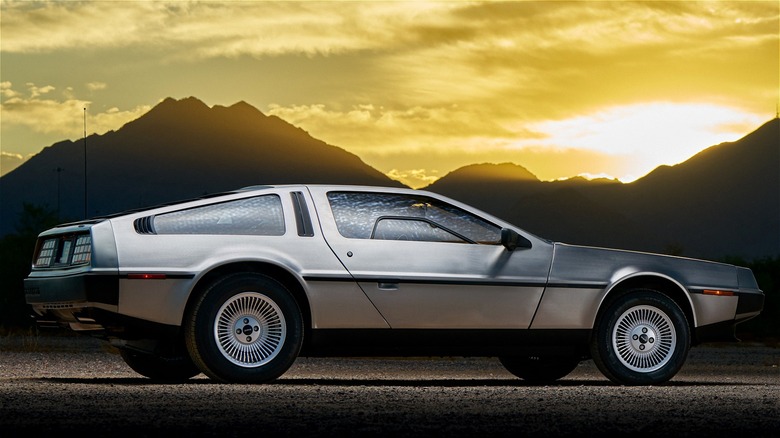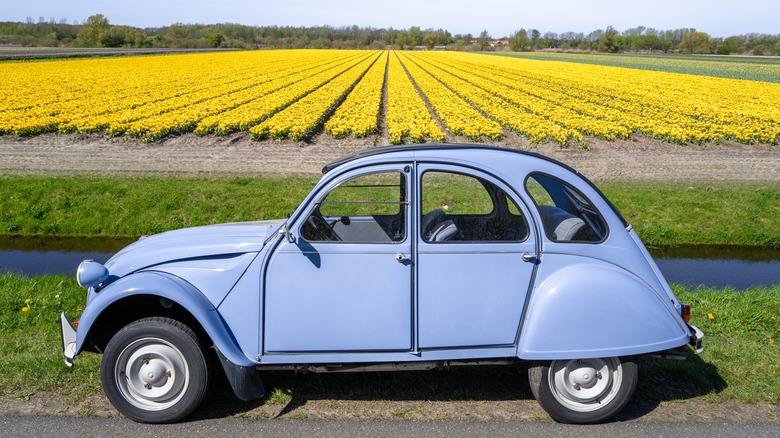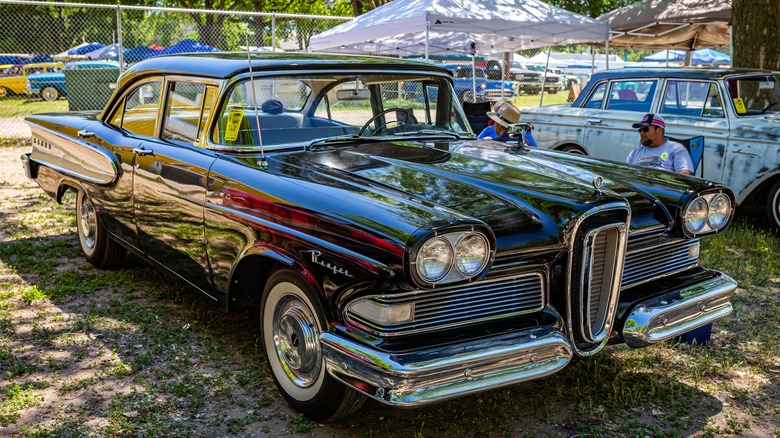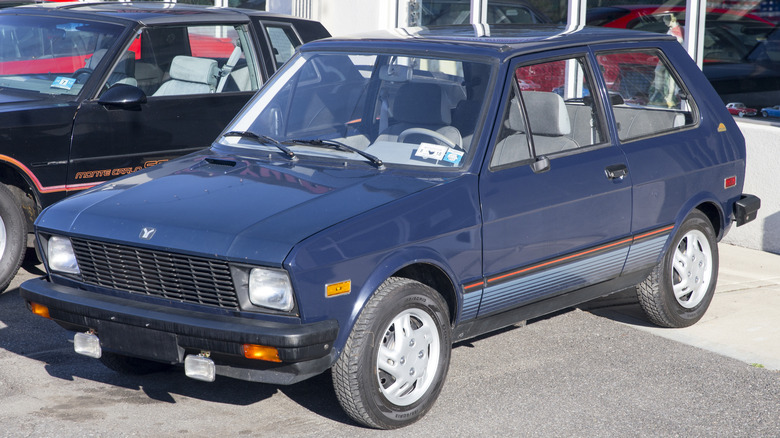10 Classic Cars People Love To Hate
The best classic cars can charm even the casual motorist. The sleek lines, polished chrome, and raspy engine notes exude a sense of nostalgia and elegance that can't be replicated in today's industry.
The gear heads and car enthusiasts will have all the facts and figures — horsepower, torque numbers, 0-60 time — but this is incidental to the likes of the Jaguar E-Type, Mercedes SL, and Alfa Romeo Spider — cars to be experienced, not test driven. The flash of these old beauties can bring a moment of color to anyone's day, but as any armchair psychologist will tell you, there is a thin line between love and hate.
For every dozen beloved classics is an old clunker hated for its looks, speed, reliability, and historical associations. Such cars make people of a certain age grateful to drive bland econoboxes that may dull the soul but at least get them from A to B safely, reliably, and comfortably. Here are 10 classic cars that people love to hate.
Volkswagen Beetle
Love it or hate it, the Volkswagen Beetle is one of the most important cars in motoring history. The rather endearing little hatchback began life not in flower power California but in Nazi Germany.
It was the early 1930s and Adolph Hitler commissioned Ferdinand Porsche to design a modest, reliable car for the masses. The engineer's response was a rear-engine, air-cooled hatchback with a low price tag, dependable performance, and a frugal engine.
After the Second World War, Major Ivan Hirsh of the Royal Electrical and Mechanical Engineers brought Volkswagen back to life, and the first vehicle to run off the rebuilt production line was the Volkswagen Beetle Type I.
In 2003, "Top Gear"'s James May announced the end of the classic Beetle. May said he was "chuffed to bits" about this news and described the car as "rubbish," explaining the hatchback's dubious Nazi history. The show built on this tongue-in-cheek displeasure in Season 10, episode 4, the "Botswana Special". The three presenters had to cross Botswana in classic vehicles of their choice, and if any of them failed beyond simple repairs, they would have to complete the journey in a Beetle, which they considered a disgrace.
Chevrolet Vega
The publicity is more evocative today than it was 50 years ago. It's the early 1970s and two Chevvies — a khaki coupe and a handsome burnt orange fastback — are set against the rugged Big Sur coast. These aren't full-fat muscle cars and that's part of the appeal. They are modest and accessible subcompacts with chromed good looks, far removed from the bulbous wind-sculpted non-entities of the modern industry. The performance of a 50-year-old economy car will almost always fall short, but it didn't disappoint motoring journalists of the day.
After a test drive from Denver to Phoenix, journalist John Bond described the Chevrolet Vega as the best handling economy car he'd ever driven, adding, "'The most impressive part of the trip was the phenomenal cornering power of the three Vegas. None of the other cars (VW Beetle, Toyota Corona, Ford Maverick) could begin to keep up on the switchbacks of the long descent out of Flagstaff.'"
Bond wasn't alone. All writers on the trip agreed that the Vega felt "well put together" and "fun to drive." Motor Trend even named it the car of 1971.
Despite this, the Vega became one of Chevy's biggest flops. There was widespread rust, engine backfires, jammed throttles, temperature issues, and a rear axle with a habit of detaching. Within a year of release, at the end of 1972, up to 95% of Vega models had critical safety flaws.
Decades later, Car and Driver named the Chevrolet Vega one of the most embarrassing award winners in automotive history.
Cadillac Cimarron
The Cadillac Cimarron is one of the most hated Cadillacs — especially the pre-facelift 1985 model. The luxury firm attempted to produce a subcompact in response to the 1979 energy crisis, which hiked oil prices until the mid-1980s. To achieve this, Cadillac used not the customary V8, V6, or straight six engines, but an inline-four with a pathetic 86-88 horsepower, depending on whether you had the 1.8 or 2.0-liter model. Designers complemented this tepid block with boxy styling, a cheap interior, and minimal trunk space compared to other Cadillacs.
Cadillac touted its creation as "a new kind of Cadillac for a new kind of Cadillac owner," but this new consumer never arrived in meaningful numbers. Cadillac fanciers wanted the real thing — a full-fat American motor with a big engine, luxury trim, and velvet suspension. Any attempts to undercut this package and the Cadillac demo — golfers in their 50s — would migrate to the automaker's European rivals, namely Mercedes and BMW.
The Cimarron sold only a third of its predicted volume, and Cadillac's market share dropped through the remainder of the 20th century. Today, the Cimarron is considered one of the worst cars ever made.
Triumph Stag
Produced from 1970 to 1977, the Triumph Stag represented everything good and bad about the British car industry of the day. It was gorgeous and distinctive, but shoddily made and exasperatingly unreliable. The V8 convertible boasted Italian styling to compete with the best of BMW, Mercedes, and other European luxury carmakers. But Giovanni Michelotti's design and the punchy engine notes were not enough to carry this flawed offering.
Under the hood was a 3.0-liter cast iron block producing 145 horsepower. A modest number, you may think, but that wasn't what made this one of the worst engines ever put in a production vehicle. The real issue was its persistent overheating problem, which warped the aluminum cylinder heads and quickly rendered the Stag an ornament rather than a motor car.
Aside from a Mk II upgrade in 1973, British Leyland did little to improve its ailing flagship grand tourer — the conglomerate was already an institutional mess and headed for collapse, which it did in 1986 after over a decade of strikes and mismanagement.
Cheap second-hand Stags are best avoided today unless you have money to spend (or waste.) However, models with extensive service histories and engine mods do exist, finally capable of achieving the style and pleasure the car failed to deliver in the 1970s.
DeLorean DMC-12
"Back to the Future" may have made the DeLorean DMC-12 a pop culture icon, but in the early 1980s many considered one of the coolest cars with gullwing doors an overpriced novelty.
The 1985 science fiction film featured a DeLorean capable of time travel once it hit 88 mph. Iconic shots of the stainless steel sports car burning through time and space provided DeLorean with some of the best free publicity in cinematic history. Dut the decade-defining smash hit could not improve the DMC-12's second-rate engineering, something the cast and crew soon found out.
"As cool as it looks on film, it's by no means a performance car," said co-writer Bob Gale in an interview with Esquire, "It broke down a lot, and little things on the car would break during a scene, and we'd have to wait for the FX guys to repair it."
In reality, hitting 88 mph in a DeLorean sounds like going pedal to the metal in a budget compact; the thin torque and flat notes make for an entirely underwhelming experience. With a paltry 130 horsepower charging a 2,718-pound body, what more could you reasonably expect?
Citroën 2CV
The Citroen 2CV is often compared with the Volkswagen Beetle. Unassuming and simply made, both are distinctive symbols of post-war Europe intended to bring freedom to the masses across the cities, towns, and villages of their respective countries and beyond. The 2CV was especially humble, as designer Pierre-Jules Boulanger sought to attract French farmers away from the predominant horses and carts of the era.
Like the Beetle, the 2CV was also a counterculture icon beloved of shaggy-haired, bell-bottomed hippies. However, some aren't caught up in all the romantic modesty. Nick Rufford of the Times referred to the 2CV's "paper-thin metal" and "fug of noxious fumes from its flat twin-cylinder air-cooled engine."
Motoring journalist Jeremy Clarkson has made a point of hating the Citroen 2CV. "This car is the harbinger of everything that's gone wrong in the world," Clarkson explained to James May in Season 4, Episode 4 of "The Grand Tour," "... it's awful."
Clarkson's typically bombastic style aside, his opinion speaks to the car's dubious electrics, crunching gear changes, and incredibly weak powertrain. The 2CV may be an icon of Gallic quirk, but it's also something of a lawnmower.
AMC Pacer
A two-door hatchback, the distinctively styled AMC Pacer entered the U.S. market in 1975 and left it just four years later on December 3, 1979. AMC described its car as "futuristic," "bold" and "unique," but widespread derision of the Pacer's wide body and large wraparound windows soon popularized "the fish bowl" as a leading nickname.
The problems were beyond the aesthetic, too. The Pacer weighed 3,000 pounds, 1,000 pounds heavier than both the Ford Pinto and the Chevrolet Chevette. A straight-six engine powered this hefty bulk, producing anywhere from 88 to 120 hp, depending on the year. A V8 model pushed the output as high as 130 hp, but no model could push beyond 103 mph or a meager 20 mpg — the Pacer was fat, slow, and thirsty.
Time has not been kind to the Pacer. A small consolation came in 1992 when a pastel blue 1976 Pacer with a fire-spitting livery appeared in "Wayne's World," but that loving nod was perhaps not quite an image booster.
Edsel Ranger
Imposing and charismatic, the Edsel Ranger would turn many heads today with its classic '50s charm. However, historians remember the mid-century sedan as Ford's biggest flop.
The Ford Motor Company established Edsel as a premium brand in 1957. Confidence in Edsel was so high that Ford developed it in secret to create maximum buzz on launch day. Market research was therefore very limited and the pulse of consumer preferences almost entirely missed.
The launch did not go as planned. Many criticized the brand's appearance, comparing the vertical grill to a horse collar. But customers nonetheless came and Edsels sold, and that's when the real problems started.
When Ford finally surveyed customers, it found that Edsels had poor welding, leaky trunks, and faulty power steering. The Teletouch shifter was difficult to service, too.
By 1960, after 116,000 models sold, Ford announced the Edsel's discontinuation, smashing second-hand market value and affirming the brand's failure. In total, the debacle cost Ford up to $250 million — around 2.5 billion in 2024 prices.
A classic though the Edsel range may be today, the brand's story is best remembered as one of corporate complacency.
Chevrolet Corvair
In 1960, General Motors unveiled the Chevrolet Corvair, impressing the industry with its rear mounted aluminum engine, independent suspension, unibody construction, and enviable styling. The reception was so positive that Time put the Corvair on its cover and Motor Trend named it Car of the Year for 1960.
Sales were decent and peaked at 235,000 in 1965. The Corvair may have continued upwards if it wasn't for Ralph Nader's "Unsafe at Any Speed," a broadside against the U.S. car industry's safety record. An activist and future presidential candidate, Nader took aim at the Corvair in the first chapter, arguing that the sedan's rear mounted engine was too heavy for the swing axles and prone to serious instability. He also noted that the Corvair's heat exchangers, which pumped warm air into the interior, was prone to rust and perforation, channelling toxic fumes into the cabin.
GM had already superseded Nader's axel complaint regarding the 1960-63 model, but the optics proved too powerful. Corvair sales plummeted until 1969, when GM discontinued the model.
Historians may point to the Corvair's innovation, but the Chevy sedan will never escape the stain of "Unsafe at Any Speed."
Yugo GV
Most of these classics have at least something going for them. Maybe they are pretty, comfortable, sharp in a corner, or at least innovative in some way. Alas, none of this — or anything else positive — can be said of this slow, cheap, and abysmally made Serbian hatchback. Many feel the Yugo GV is the worst car ever sold in America.
Master pitch artist Malcolm Bricklin began importing the GV — meaning Good Value — in 1985 for a price of just $3,990, making it the cheapest car yet sold in the United States. Bricklin expected to sell 50,000 but sold 163,000, earning $20 million for himself.
Bricklin got rich, but what did the American people get? Well, they got 0-60 in 14 seconds and a spine rattling top speed of 86 mph. They also got no air conditioning, ugly materials, dirty emissions, wayward reliability, and dangerously poor crash tests.
Car and Driver's technical director Csaba Csere famously wrote,"It's obvious to me that the Yugo GV is inferior to every other car sold in America."
This was clearly not sustainable. In 1992, Yugo America went bankrupt as Yugoslavia plunged into civil war; the United Nations sanctioned the automaker, and NATO bombed its Zastavia factory in 1999.
[ Featured Image by Mr.choppers via Wikimedia Commons | Cropped and scaled | CC BY-SA 3.0 ]










